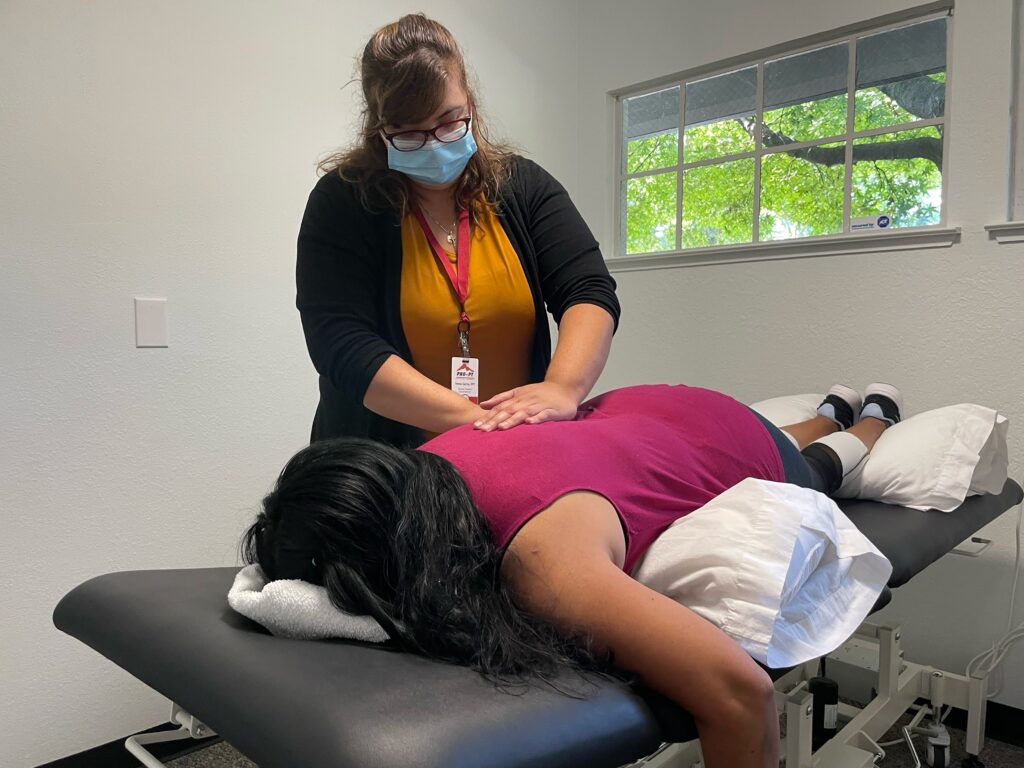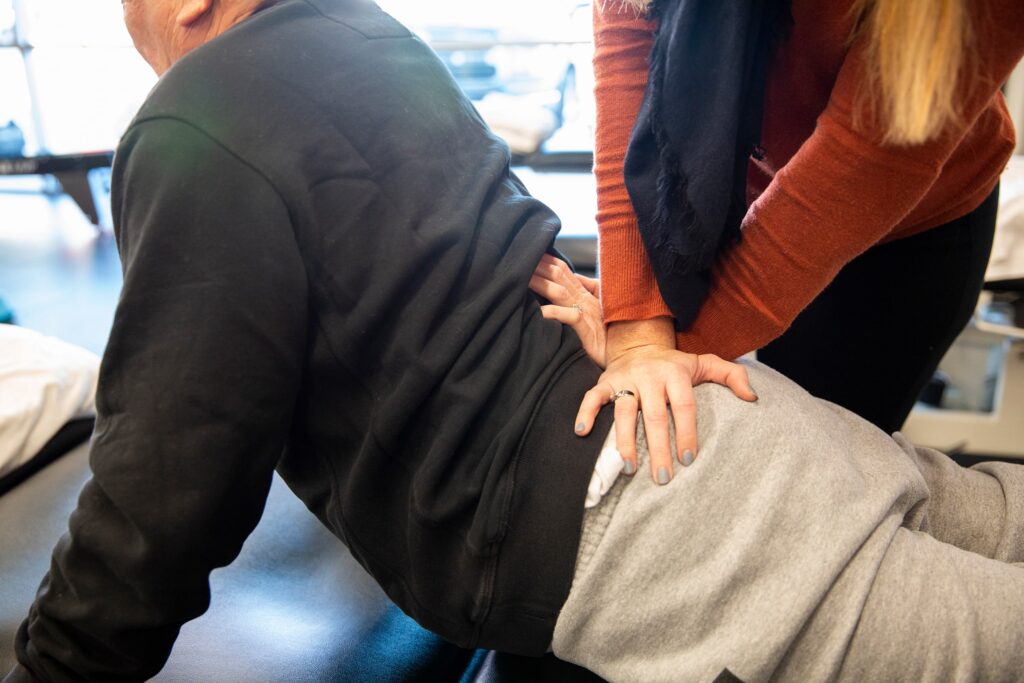Our commitment to our patients is what really makes PRO~PT stand out in the Central Valley. This is possible because of our equal commitment to training our physical therapists and physical therapy assistants by using up-to-date research to ensure we deliver the best assessment and treatment to our patients. Our patient care methodology is based on The McKenzie Method of Mechanical Diagnosis and Therapy (MDT).

What is the McKenzie Method?
The McKenzie Method of Mechanical Diagnosis and Therapy was developed by physical therapist Robin McKenzie over 60 years ago.
Contrary to popular belief, this isn’t simply a method of treatment. Nor is it just for spinal issues. MDT is a reliable assessment system that is applicable to all musculoskeletal injuries, regardless of the medical diagnosis, resulting in a mechanical diagnosis that helps your provider understand the underlying cause, presentation, and behavior of your symptoms.
This assessment leads the practitioner directly to the most appropriate treatment method for the patient, with an emphasis on patient education and patient self-treatment through the guidance of the practitioner. MDT is well-researched, exercise-based, and patient-empowering, resulting in less time at the doctor’s office and less money spent on medical care.
What is MDT?
MDT is a high standard of care in physical therapy because it is:
- Well-researched
- Efficient
- Effective
- Patient-empowering
- Emphasizes return to function
- Emphasizes prevention
How Does MDT Work?
Physical therapy using The McKenzie Method MDT has a specific process that puts the patient first.
- Active Listening: The assessment begins with the practitioner taking a detailed history from the patient to understand the patient’s symptoms, symptom behavior, lifestyle, and any limitations. It also takes into account other medical histories that could impact the patient’s treatment.
- Active Physical Examination: The practitioner performs an assessment of the patient’s movement, symptoms, and function, utilizing these tests as baselines for future comparison.
The practitioner then assesses the patient’s response to repeated motions and/or positions to establish a direction for treatment. (This would be like your mechanic opening the hood of your car and also taking it for a test drive to determine the problem). - Active Patient Treatment: The practitioner educates the patient on a clear treatment program that includes specific movements or exercises to be performed at prescribed intervals, as well as guidance on expectations.
Education is also provided on which activities to avoid outside of the clinic, including specific education on posture and lifestyle adjustments. The patient performs the prescribed treatment program and follows up with the practitioner at established intervals. - Re-Evaluation and Follow-Up: Upon follow-up, the practitioner assesses the patient’s response to treatment against the baselines established at the initial assessment, making adjustments or progressions as needed. The practitioner continues to treat and guide the patient, only manually intervening as needed to maximize the effectiveness of the treatment.
- Patient Education and Prevention: Throughout the treatments, the practitioner educates the patient on self-treatment until the maximum desired improvement is achieved. Afterward, the practitioner educates the patient on physical maintenance and prevention of pain recurrence before their physical therapy journey is completed.

What Does Being MDT Certified for Physical Therapy Mean?
Physical therapists properly trained in MDT are able to better understand their patient’s symptoms, develop a mechanical diagnosis, and determine the best treatment plan for their patients.
After completing both entry-level and advanced MDT coursework, a PT can apply to become certified in MDT, which includes successful completion of a written and practical credentialing exam.
MDT certification demonstrates advanced clinical competency of a physical therapist’s understanding and proficiency in using the MDT treatment method. PRO~PT strives for all of our physical therapists and physical therapy assistants to be trained in and use this method.
How is MDT Different than other Treatment Methods
MDT is both an assessment system and a treatment method. It’s not just a group of different exercises.
One of the key differentiators is that this assessment system leads to a clinical classification, which then provides the foundation and roadmap for the treatment plan that will work best for the patient.
Some other key differentiators include:
- MDT is backed by years of research and evidence to support the efficacy of this method.
- MDT treatment plans are individualized. Patients are provided with a treatment plan specific to their needs and goals.
- MDT is efficient. Patients typically respond quickly, getting results in as few as 2-3 treatments.
- MDT emphasizes less treatment by utilizing active treatments with little to no equipment or modalities needed. This is beneficial for patient independence.
- MDT is very cost-effective due to the quick response to treatment.
- MDT is low-risk. This type of treatment is conservative and non-invasive, minimizing the risk to the patient.
MDT is preventative. MDT emphasizes prevention by actively educating the patient on cause-and-effect, activities, and modifications to reduce the recurrence of symptoms.

How the McKenzie Method Is Different Than Other Physical Therapy Methods
The McKenzie Method of MDT physical therapy is a proven physical therapy methodology that is backed by numerous studies.
In fact, the evidence for MDT-guided physical therapy in patients who exhibit “centralization” or “directional preference”—core pieces of the MDT treatment program—is so strong that the American Physical Therapy Association published the following statement in their Clinical Practice Guidelines for Low Back Pain:
“Clinicians should use specific repeated movements to promote centralization in patients with acute, subacute or chronic low back pain, with the recommendation based on Grade A, ‘strong evidence.’”
Studies Supporting the Use of the McKenzie Method of MDT
A randomized control trial in 2012 showed that patients with severe sciatica responded significantly better to treatment using MDT methods compared to alternative therapy treatments (Albert, 2012). The patients in the study had an average of only 5 treatments. The MDT group had significantly superior results on the following outcomes:
- Global Improvement
- Sick Leave
- Work Status
- Nerve Root Compression Signs
- Patient Satisfaction
Another randomized control trial conducted in 2011 compared the long-term outcomes of patients with low back pain who received treatment with MDT methods against patients who received spinal manipulation.
This study found that patients treated with MDT methods had higher success rates than those treated with spinal manipulation (Peterson, 2011).






